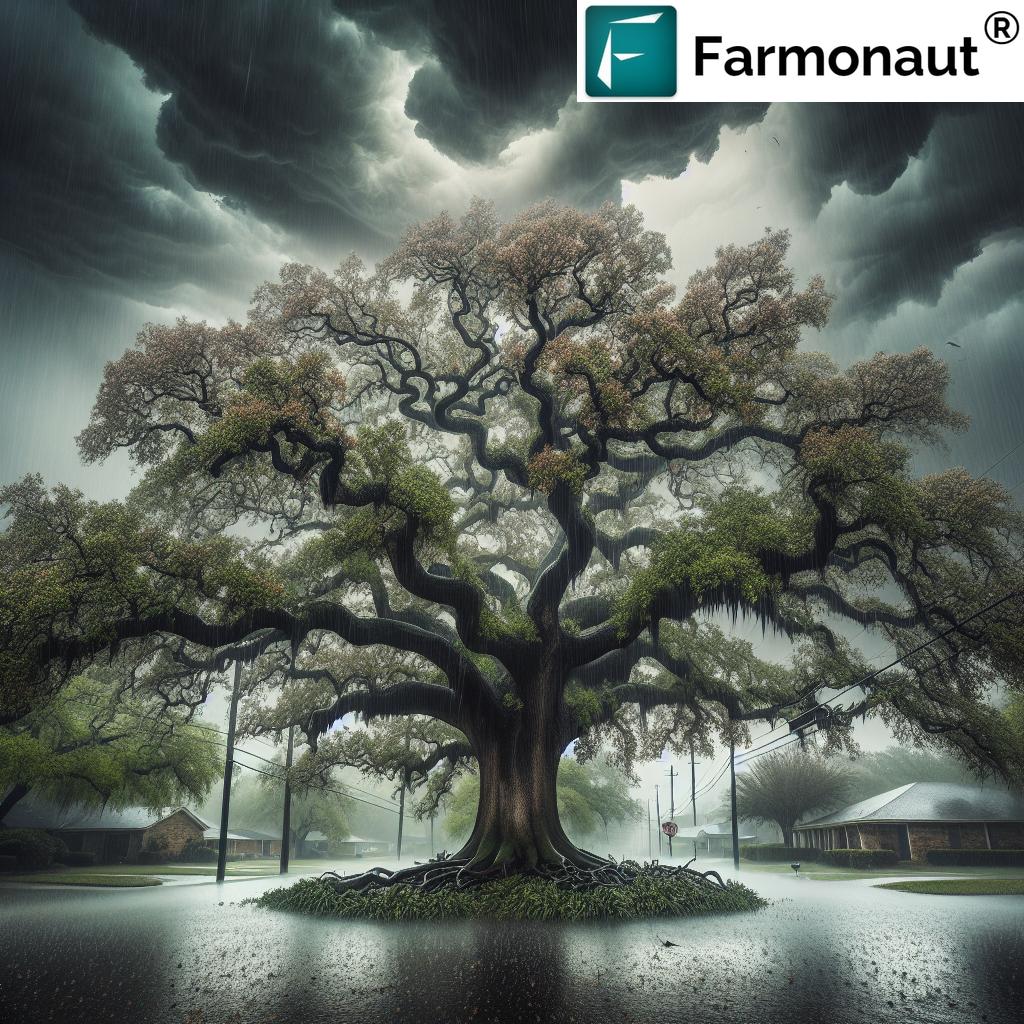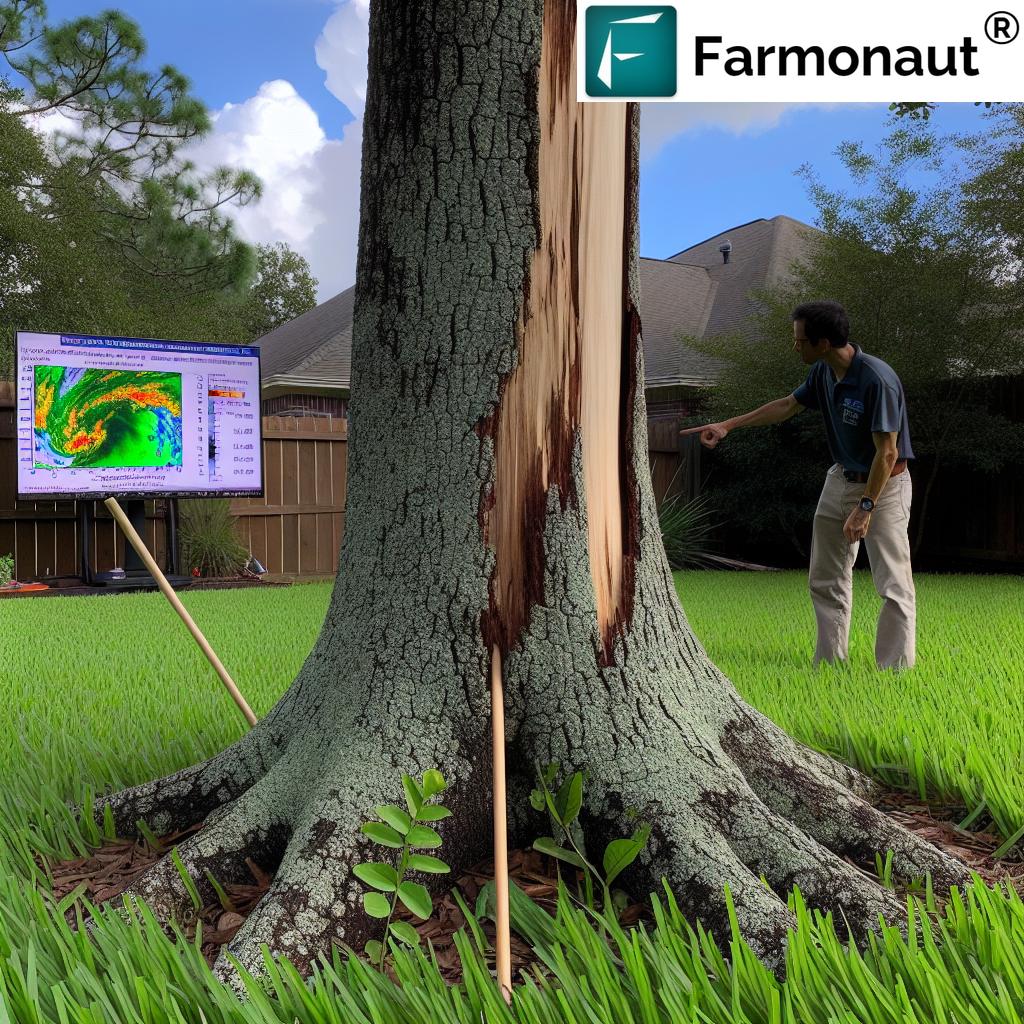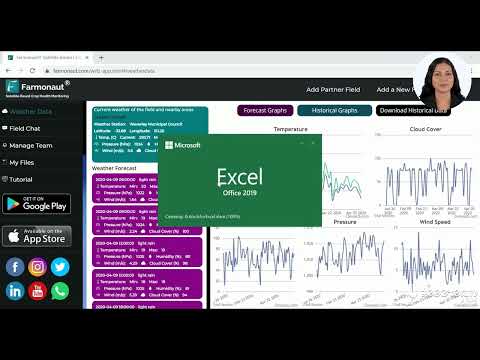Protect Your Trees: Essential Spring Storm Safety Tips for Baton Rouge Homeowners
“In Baton Rouge, spring storms with winds over 60 mph can increase tree fall risk by up to 40% in saturated soils.”
As the vibrant colors of spring paint Baton Rouge’s landscape, we’re reminded of the beauty our trees bring to our community. However, with the arrival of spring comes the potential for severe storms that can threaten the safety of our beloved trees and, consequently, our homes and families. In this comprehensive guide, we’ll explore essential spring storm safety tips for Baton Rouge homeowners, helping you protect your trees and property from the unpredictable forces of nature.
Understanding the Threat: Spring Storms in Baton Rouge
Baton Rouge, our beautiful capital city, is no stranger to extreme weather events. Recent incidents across the capital area have highlighted the dangers that spring storms pose to our urban forest. Heavy rainfall, combined with high winds, has led to significant flooding and road closures, primarily due to fallen trees. To better prepare ourselves and our trees, it’s crucial to understand the unique challenges that spring weather brings to our region.

The Perfect Storm: Heavy Rain and High Winds
Storm Station Meteorologist Emma Kate Cowan explains, “During the spring and warmer seasons, we typically see storm systems with heavier downpours, and we can get one to three inches of rain in a short amount of time.” This intense rainfall saturates the soil, weakening the ground’s ability to hold tree roots firmly in place. When combined with gusty winds, often exceeding 30 miles per hour, the result can be catastrophic for our trees.
The impact of these weather conditions is twofold:
- Saturated Soil: Excessive moisture in the ground reduces soil stability, making it easier for trees to uproot.
- High Winds: Strong gusts can exert tremendous force on tree canopies, especially those weakened by previous weather events or poor health.
This combination creates a perfect storm scenario, increasing the risk of trees falling and potentially damaging property or power lines.
The Lingering Effects of Past Weather Events
It’s not just the immediate weather conditions that pose a threat to our trees. Scott Courtright from Louisiana Tree Service points out a critical factor often overlooked: “Trees have been under stress due to previous droughts and a recent freeze, making them more fragile.” This pre-existing stress can significantly impact a tree’s ability to withstand spring storms.
Courtright elaborates, “The droughts and freeze caused the trees to shrink and become brittle. This makes them more susceptible to damage.” Understanding this vulnerability is crucial for implementing effective tree damage prevention strategies.
Tree Care During Extreme Weather: Essential Practices
To mitigate the risks associated with spring storms, homeowners must adopt proactive tree care practices. Here are some essential strategies to ensure your trees remain healthy and resilient in the face of extreme weather:
1. Regular Tree Inspections
One of the most critical aspects of tree care during extreme weather is regular inspections. By examining your trees frequently, you can identify potential issues before they become severe problems during a storm. Look for:
- Dead or dying branches
- Cracks in the trunk or major limbs
- Signs of disease or pest infestation
- Leaning trees or exposed roots
If you’re unsure about what to look for or how to assess tree health, consider consulting with a professional arborist. They can provide expert guidance and help you develop a comprehensive tree care plan.
2. Proper Pruning Techniques
Pruning is an essential aspect of tree maintenance, especially when it comes to protecting trees from high winds. However, it’s crucial to use correct pruning techniques to avoid causing more harm than good. Here are some pruning tips:
- Remove dead, diseased, or damaged branches promptly
- Thin the canopy to reduce wind resistance
- Avoid topping trees, as this can lead to weak regrowth
- Prune during the dormant season when possible
Remember, improper pruning can weaken trees and make them more susceptible to storm damage. If you’re not confident in your pruning skills, it’s best to hire a certified arborist to handle this task.
3. Soil Management and Root Care
Healthy roots are crucial for a tree’s stability and overall health. To promote strong root systems and mitigate saturated soil tree risks, consider these practices:
- Implement proper drainage solutions around your trees
- Use mulch to retain moisture and protect roots (but avoid piling mulch against the trunk)
- Avoid compacting soil around tree roots
- Consider aeration techniques for heavily compacted soils
By focusing on root health, you can significantly improve your trees’ ability to withstand heavy rains and strong winds.

4. Proper Watering Techniques
While Baton Rouge often experiences heavy rainfall during spring storms, proper watering is still essential for maintaining tree health, especially during drier periods. Here are some watering tips:
- Water deeply and infrequently to encourage deep root growth
- Use a soaker hose or drip irrigation system for efficient watering
- Adjust watering based on rainfall and soil moisture levels
- Avoid overwatering, which can lead to root rot and soil instability
Proper watering techniques can help trees recover from drought stress and improve their overall resilience to storm damage.
Storm Preparation Tips: Protecting Your Trees and Property
“Regular tree inspections and pruning can reduce storm-related damage risks by up to 30% for Baton Rouge homeowners.”
As spring storms approach, it’s crucial to take proactive steps to protect your trees and property. Here are some essential storm preparation tips for Baton Rouge homeowners:
1. Create a Tree Emergency Plan
Developing a comprehensive tree emergency plan is an essential step in preparing for spring storms. This plan should include:
- A list of emergency contacts, including local tree services and utility companies
- An inventory of your trees, noting their species, age, and any pre-existing conditions
- A map of your property showing the location of trees and potential hazards
- Guidelines for post-storm assessment and cleanup
Having this plan in place will help you respond quickly and effectively in the event of storm-related tree damage.
2. Implement Tree Support Systems
For trees that are particularly vulnerable to storm damage, consider implementing support systems such as:
- Cabling and bracing for trees with weak branch unions
- Lightning protection systems for tall or isolated trees
- Windbreaks or protective barriers for young or newly planted trees
These systems can provide additional stability and protection during severe weather events.
3. Create Flood-Resistant Landscaping
Flood-resistant landscaping is crucial for protecting your trees and property from the effects of heavy rainfall. Consider these strategies:
- Install proper drainage systems to divert water away from trees and structures
- Use permeable paving materials to reduce runoff
- Plant native species that are adapted to local rainfall patterns
- Create rain gardens or bioswales to manage excess water
These landscaping techniques can help mitigate the risks associated with saturated soil and reduce the likelihood of tree fall during storms.
4. Secure Loose Items
Before a storm hits, take time to secure any loose items in your yard that could become projectiles in high winds. This includes:
- Outdoor furniture
- Gardening tools and equipment
- Potted plants
- Decorative items
By securing these items, you reduce the risk of them causing damage to your trees or property during a storm.
Understanding Heavy Rain and Wind Effects on Tree Health
To effectively protect our trees, it’s essential to understand how heavy rain and strong winds impact tree health. This knowledge will help us implement more targeted tree damage prevention strategies.
The Impact of Heavy Rain
While trees need water to thrive, excessive rainfall can have several negative effects:
- Soil Saturation: Oversaturated soil can lead to root suffocation and increased susceptibility to uprooting.
- Nutrient Leaching: Heavy rain can wash away essential nutrients from the soil, potentially leading to deficiencies.
- Fungal Growth: Excess moisture can promote the growth of harmful fungi and other pathogens.
- Physical Damage: The weight of water on leaves and branches can cause breakage, especially in already weakened trees.
The Effects of Strong Winds
High winds pose significant threats to trees, particularly when combined with saturated soil:
- Branch Breakage: Strong gusts can snap branches, especially those weakened by disease or poor structure.
- Canopy Stress: Persistent winds can cause leaves to dry out and potentially defoliate trees.
- Root Damage: As trees sway in the wind, roots can become damaged or loosened in the soil.
- Uprooting: In extreme cases, high winds can completely uproot trees, particularly those with shallow root systems or growing in saturated soil.
Understanding these effects helps us appreciate the importance of proactive tree care and storm preparation.
Addressing Tree Stress: Recovery and Long-term Care
After a storm or prolonged period of stress, trees may require special attention to recover and regain their health. Here are some strategies for addressing tree health after droughts and other stressors:
1. Post-Storm Assessment
After a severe weather event, conduct a thorough assessment of your trees:
- Check for visible damage such as broken branches or split trunks
- Look for signs of uprooting or leaning
- Assess the overall structure and stability of each tree
- Document any damage for insurance purposes
If you’re unsure about the extent of damage or the stability of a tree, consult a professional arborist for a more detailed assessment.
2. Proper Pruning and Wound Care
For trees that have suffered storm damage:
- Remove any broken or damaged branches using proper pruning techniques
- Clean up ragged wounds to promote faster healing
- Avoid using wound dressings, as they can trap moisture and promote decay
- Monitor pruned areas for signs of disease or pest infestation
3. Soil Rehabilitation
To help trees recover from stress and improve their resilience:
- Address soil compaction through aeration techniques
- Replenish nutrients with appropriate fertilizers based on soil tests
- Apply organic mulch to retain moisture and improve soil structure
- Consider using mycorrhizal fungi products to enhance root health
4. Ongoing Monitoring and Care
Recovery from stress is an ongoing process. Continue to monitor your trees for:
- Signs of new growth and improved vigor
- Any indications of secondary problems such as pest infestations or diseases
- Changes in soil moisture levels or drainage patterns
- Overall structural integrity and stability
Regular care and attention will help ensure your trees recover fully and remain resilient in the face of future challenges.
Leveraging Technology for Tree Care and Storm Preparedness
In today’s digital age, technology can play a crucial role in helping Baton Rouge homeowners care for their trees and prepare for spring storms. One such innovative solution is Farmonaut, a pioneering agricultural technology company that offers advanced, satellite-based management solutions.
While primarily focused on agricultural applications, Farmonaut’s technology can also be beneficial for urban tree care and storm preparedness. Here’s how:
1. Satellite-Based Monitoring
Farmonaut’s satellite imagery capabilities can help homeowners and arborists monitor tree health on a larger scale. This technology can be particularly useful for:
- Identifying areas of stress or decline in tree canopies
- Monitoring soil moisture levels across properties
- Tracking changes in vegetation health over time
By leveraging this data, homeowners can take proactive measures to address potential issues before they become critical during storm events.
2. Weather Forecasting and Alerts
Accurate weather forecasting is crucial for storm preparedness. Farmonaut’s platform includes advanced weather data that can help Baton Rouge residents:
- Anticipate severe weather events with greater accuracy
- Receive timely alerts about potential threats to trees
- Make informed decisions about tree care and storm preparation
To learn more about accessing and utilizing weather data through Farmonaut, check out this helpful tutorial:
3. Data-Driven Decision Making
By integrating Farmonaut’s API into local tree care applications, arborists and city planners can make more informed decisions about urban forest management. This data-driven approach can help:
- Identify areas most at risk for storm-related tree damage
- Optimize resource allocation for tree maintenance and storm preparation
- Develop more effective long-term strategies for urban forest resilience
For those interested in integrating Farmonaut’s data into their own systems, this comprehensive tutorial on using the Farmonaut API can be extremely helpful:
While Farmonaut’s primary focus is on agricultural applications, its technology has the potential to revolutionize urban tree care and storm preparedness in Baton Rouge. By leveraging these advanced tools, homeowners and city officials can work together to create a more resilient urban forest that can better withstand the challenges of spring storms.
Community Engagement and Education
Protecting Baton Rouge’s urban forest is a community effort. Engaging and educating residents about proper tree care and storm preparedness is crucial for creating a more resilient city. Here are some ways to promote community involvement:
1. Tree Planting Initiatives
Organizing community tree planting events can help:
- Increase the overall tree canopy in Baton Rouge
- Educate residents about proper tree selection and planting techniques
- Foster a sense of community ownership and pride in the urban forest
2. Workshops and Seminars
Hosting educational events on topics such as:
- Basic tree care and maintenance
- Identifying and reporting potential tree hazards
- Storm preparation techniques for homeowners
- The benefits of trees in urban environments
3. Citizen Science Programs
Engaging residents in data collection and monitoring efforts can help:
- Increase awareness of tree health issues
- Provide valuable data for urban forest management
- Foster a deeper connection between residents and their local environment
4. Social Media and Online Resources
Utilizing digital platforms to:
- Share timely information about storm preparedness
- Provide tips for tree care and maintenance
- Create online communities for sharing knowledge and experiences
By fostering a community-wide commitment to tree care and storm preparedness, Baton Rouge can build a more resilient and beautiful urban forest for generations to come.
Tree Storm Safety Checklist
| Task | Frequency | Importance Level |
|---|---|---|
| Tree Inspection | Monthly | High |
| Pruning Dead/Weak Branches | Seasonally | High |
| Soil Management | Quarterly | Medium |
| Tree Support Systems Check | Annually | Medium |
| Root Care | Seasonally | High |
| Lightning Protection Inspection | Annually | Low |
| Emergency Tree Service Contact Update | Annually | High |
Conclusion: Embracing a Proactive Approach to Tree Care
As we’ve explored throughout this guide, protecting our trees from spring storms in Baton Rouge requires a comprehensive and proactive approach. By understanding the unique challenges posed by our local climate, implementing proper tree care practices, and leveraging technology and community resources, we can create a more resilient urban forest that enhances the beauty and safety of our city.
Remember, healthy trees are better equipped to withstand the forces of nature. Regular inspections, proper pruning, soil management, and storm preparation are all crucial elements in maintaining the health and stability of our trees. By following the tips and strategies outlined in this guide, Baton Rouge homeowners can significantly reduce the risk of storm-related tree damage and contribute to a greener, safer community.
Let’s work together to protect our trees, our homes, and our city from the impacts of spring storms. With knowledge, preparation, and community engagement, we can ensure that Baton Rouge’s urban forest continues to thrive for generations to come.
FAQs
- Q: How often should I have my trees professionally inspected?
A: It’s recommended to have a professional arborist inspect your trees at least once a year, preferably before the spring storm season. - Q: Can I prune my trees myself, or should I always hire a professional?
A: While minor pruning can be done by homeowners, it’s best to hire a certified arborist for significant pruning, especially for large trees or those near structures. - Q: How can I tell if a tree on my property is at risk of falling during a storm?
A: Look for signs such as leaning, exposed roots, cracks in the trunk, dead branches, or fungal growth. If you’re unsure, consult a professional arborist. - Q: What should I do if a tree falls on my property during a storm?
A: First, ensure everyone’s safety and call emergency services if necessary. Then, contact your insurance company and a professional tree service for removal. - Q: Are some tree species more resistant to storm damage than others?
A: Yes, some native species are generally more wind-resistant. Consult with a local arborist or extension office for recommendations suitable for Baton Rouge.
Earn With Farmonaut: Earn 20% recurring commission with Farmonaut’s affiliate program by sharing your promo code and helping farmers save 10%. Onboard 10 Elite farmers monthly to earn a minimum of $148,000 annually—start now and grow your income!
For more information on Farmonaut’s affiliate program, visit https://farmonaut.com/affiliate-program.
Explore Farmonaut’s Solutions
While Farmonaut’s primary focus is on agricultural applications, their technology can be adapted for urban tree care and management. Learn more about their innovative solutions:
- Carbon Footprinting: Understand and reduce environmental impact in urban forestry management.
- Traceability: Enhance transparency in tree care and maintenance practices.
- Crop Loan and Insurance: Explore potential applications for urban tree protection and risk management.
- Fleet Management: Optimize tree care operations and resource allocation.
- Large Scale Farm Management: Adapt strategies for managing extensive urban forest areas.
- Crop Plantation Forest Advisory: Gain insights applicable to urban tree planting and maintenance.
Explore Farmonaut’s offerings and see how their technology can be adapted for urban tree care:
For developers interested in integrating Farmonaut’s data into custom applications, explore their API options:





